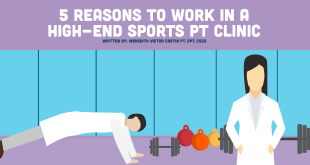1. Create a culture of mobility
There is a wealth of research describing the benefits and importance of early mobility in the cardiovascular intensive care unit (CVICU). The proven benefits range from reducing length of stay, to reducing hospital costs, to improving function one year after discharge from the ICU. For this reason, it is essential that the ICU physical therapist creates a culture of mobility instead of a culture of sedation and bed rest.
As an ICU physical therapist, you must make it your daily mission to get your patients out of bed and ambulating if possible, all while maintaining maximum independence. Doing this regularly and safely will drive momentum amongst patients, and will raise the mobility expectations for patients in the CVICU.
The CVICU is a team environment. Everyone has an essential role, especially the ICU physical therapist. It is not dramatic to say that you will encounter patients who will never leave the CVICU and may even die in the hospital if they become deconditioned by weeks of bedrest.
Create a culture of mobility. You’ll save lives.
2. You can do more than you think as an ICU physical therapist
While practicing in a CVICU, you’ll encounter some pretty scary patient scenarios, ranging from intubated patients, patients on continuous renal replacement therapy (CRRT), intra-aortic balloon pumps (IABP), and extracorporeal membrane oxygenation (ECMO). It is important to know what treatments are safe and when physical therapy may be contraindicated.
I treat patients who are in such severe respiratory failure that they require mechanical ventilation for weeks while waiting for a lung transplant. If these patients had been on strict bedrest for weeks, they would have become so deconditioned that they may not be able to survive the transplant procedure.
Patients with acute renal failure can stand and march at the edge of the bed while on CRRT. Femoral catheters are not a contraindication to movement. There is a plethora of convincing evidence that highlights specific instances commonly encountered in the CVICU and when it is safe to mobilize people on invasive therapies. Be the person who confidently leads the wave of change.
3. Choose practical assessment tools
As a new grad ICU physical therapist, you may have ideas of using Berg Balance Scales and Dynamic Gait Indexes with your patients. This is rarely practical in an ICU. However, I still believe that it is important to use evidence-based assessment tools.
If you want to justify your presence in the CVICU, there is no stronger ground to stand on than that of functional outcome measures. The role of the physical therapist is changing rapidly in the ICU and recent, evidence-based assessment tools have followed. The Physical Function ICU Test (PFIT) is simple, quick to administer, and considered by some to be the gold standard of ICU assessment tools. A tool I find to be more comprehensive and informative is the Perme ICU Mobility Score. This tool is a relatively recent development by arguably the world’s leading expert on ICU PT, Christiane Perme.
If you’d like to take one of Christiane Perme’s fantastic seminars, check out this link!
4. Get to know your team
The ICU is the ultimate team environment. Anyone who has been in any ICU knows that nurses absolutely run the show. Get to know them. You will get nowhere without a positive relationship with the nursing staff. That being said, you must remember that you are a consult service. When neurology gets consulted, they don’t ask permission to see the patient. Neither should you.
While I could briefly describe the significance of different ventilator settings, respiratory therapists (RT) are your go-to pros when it comes to a mechanically-ventilated patient case. When I get an intubated patient out of bed, I always have an RT at my side.
Get to know your ICU team. Without their support and trust, you will never create that all-important culture of mobility.
5. Know when to stop…and when not to start
The purpose of the CVICU is to achieve adequate organ perfusion and keep people alive. An ICU physical therapist has an essential role in this mission. However, there are times when the benefits of PT are drastically outweighed by the risks.
When you communicate with the nursing staff before treatments, there will be obvious concerns that indicate it is unsafe to treat a patient. The umbrella of hemodynamic or airway instability, as determined by you and the RN, will typically make PT unsafe. A 2014 article attempted to establish a consensus on this issue. They concluded that if oxygen saturation is greater than 90% on less than 60% inspired oxygen, and breathing is slower than 30 breaths per minute, a patient is safe to treat.
Two specific hard-stops for me are femorally-inserted ECMO and a femorally inserted IABP. These two situations mean that a patient has a rigid catheter in the femoral artery, making hip flexion an absolute contraindication. Creating a personal definition of “safe to treat” is a challenging and ongoing process that you will develop with experience in the ICU.
References
Morris PE, Goad A, Thompson C, et al. Early intensive care unit mobility therapy in the treatment of acute respiratory failure. Crit Care Med. 2008 Aug;36(8):2238-43.
Schweickert WD, Pohlman MC, Pohlman AS, et al. Early physical and occupational therapy in mechanically ventilated, critically ill patients: a randomized controlled trial. Lancet. 2009 May 30;373(9678):1874-82.
Perme, Christiane et al. “Safety and Efficacy of Mobility Interventions in Patients with Femoral Catheters in the ICU: A Prospective Observational Study.” Cardiopulmonary Physical Therapy Journal 24.2 (2013): 12–17.
Denehy L, de Morton NA, Skinner EH, Edbrooke L, Haines K, Warrillow S, et al. (2013) A physical function test for use in the intensive care unit: validity, responsiveness, and predictive utility of the physical function ICU test (scored). Phys Ther 93: 1636–1645
Kawaguchi YMF et al. Perme Intensive Care Unit Mobility Score and ICU Mobility Scale: translation into Portuguese and cross-cultural adaptation for use in Brazil. J Bras Pneumol. 2016;42(6):429-431
Perme C et al. A tool to assess mobility status in critically ill patients: the Perme Intensive Care Unit Mobility Score. Methodist Debakey Cardiovasc J. 2014 Jan-Mar;10(1):41-9.
Nawa RK et al. Initial interrater reliability for a novel measure of patient mobility in a cardiovascular intensive care unit. J Crit Care. 2014 Jun;29(3):475.
Hodgson CL, Stiller K, Needham DM, et al. Expert consensus and recommendations on safety criteria for active mobilization of mechanically ventilated critically ill adults. Critical Care. 2014;18(6):658.
Wang YT, Haines TP, Ritchie P, et al. Early mobilization on continuous renal replacement therapy is safe and may improve filter life. Critical Care. 2014;18(4)
 NewGradPhysicalTherapy.com The Largest Online Resource For New Grad Physical Therapists
NewGradPhysicalTherapy.com The Largest Online Resource For New Grad Physical Therapists









Awesome article Seb! Thanks for all the info.
Thank you Clinton. I hope it is helpful for all my colleagues out there.
Thanks for the article! Pending successful completion of the NPTE, I’ll be starting out as an ICU/acute care therapist in August. I’m so excited to be part of a mobility-friendly facility — I’ve seen the other side of the aisle as a student on rotation, and the overall QOC provided to those patients is vastly different. Way to encourage mobility advocacy!
Thanks for your comment Katie. The ICU can be an inspiring place to work. I also know the other side of the coin exists where patients are pretty much chained to their bed. No matter where you end up, I hope you’ll keep fighting the good fight. Take care